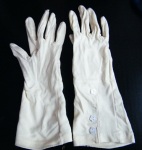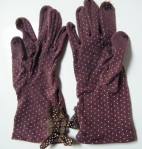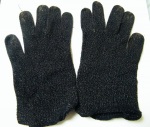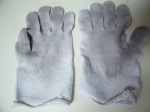I have to admit, I’m obsessed with gloves. I don’t leave the house without a pair, I have a drawer by the bed dedicated to them, and they can be found scattered all around our home. The washing line regularly sports a glove or two… or eight… or twelve.
It all started with a GP consultation for hand eczema, in which the doctor suggested that cotton gloves would be useful to protect my hands when they were very sore. I immediately had visions of a pair of cotton gloves I thought I’d seen on the shelf in the local Boots store. I went off confidently to equip myself. After an extended search of the shelves, I eventually purchased two pairs of cotton gloves – one to wear, and one to wash. Each pair of gloves came in a little cardboard box. The gloves were wide and baggy, and did not cover my wrists. If I wore them underneath washing up gloves, they would end up stuck inside the outer gloves when I removed them. Once a glove became wet, it was useless. Two pairs weren’t enough, of course, and I could see it would become expensive to buy gloves one pair at a time.
The search for cotton gloves
I decided that cotton gloves could be helpful if only I could find some that covered my wrists and fitted better. Surely that wasn’t too difficult? After all, there must be thousands of people like me who need to wear cotton gloves to protect their hands. I tried every shop in town that had the faintest chance of selling gloves of any kind. I failed dismally. At that point, I turned to the internet. After many hours of research, my first online purchase was a batch of 10 ‘cotton fourchette’ gloves at 50p each, similar to the ones in this image:
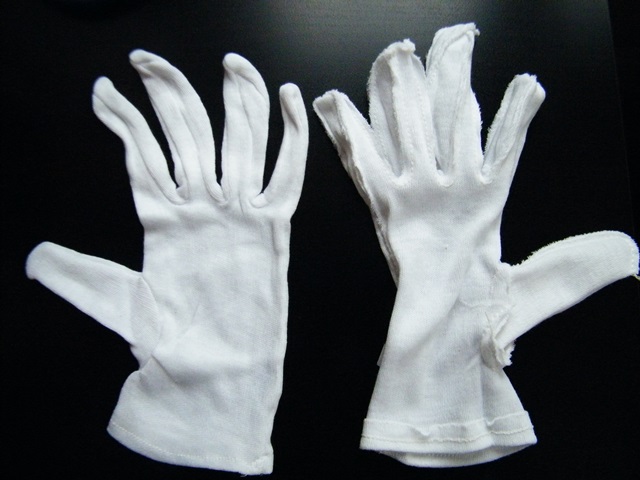
They were fine, sort of. My sore hands made me increasingly reliant on the gloves. I wore them for driving, shopping, handling most objects, and using my computer. It was okay, but they slipped around on my hands when driving and quickly became grubby when doing anything. It was very challenging to get my credit card out of my purse; touchscreens on ATMs, for example, were impossible to use. My ability to type with any accuracy took a nosedive. I could remove my gloves, of course, when using a touch screen or handling cards, but then I was exposing my sore fingers to painful experiences, and leaving a trail of Vaseline.
Then, one terrible morning, the day of a really important meeting I was chairing, I got up to find that two of my fingers were weeping sticky tissue fluid. In my panic to get to work, I donned a pair of cotton gloves and found a pair of cycling gloves that were meant to be given as a present the previous Christmas. My fingers were so sore and drippy there was no way I could actually touch anything, even with the cotton gloves. I squeezed on a cycling glove over the worst hand and, feeling protected, I drove to work. At home at the end of the day, I was still wearing the cycling glove on the badly affected hand. Fluid had soaked through into a large damp patch. I eased off the outer glove and discovered that the cotton glove was completely stuck to my fingers. Even worse, loose threads from the seams were embedded in my raw flesh. After that day, I always wore my cotton gloves inside out.
Wearing cotton gloves is never a good look, unless you are a museum curator. Worse still, is cotton gloves with the seams hanging out. Nevertheless, I championed this look for about two years at work. For a while, I tried cotton stockinette gloves, after buying a pack of 24. However, they turned out to be uncomfortable, especially because where the edges were sewn together they were less stretchy and tended to dig in. Once my fingers began poking through the ends, I gladly ditched each glove.
Outer layers are important too
There followed a frenzy of internet glove shopping: pure silk liner gloves, cycle gloves, hockey gloves, assembly grip gloves, leather gloves. I needed a soft absorbent surface next to my skin and a tough outer layer that would allow me to feel protected while generally negotiating the wider world. Preferably, the outer layer would also provide sufficient grip and dexterity to allow me to handle money and cards without removing them and risking the aggravation to my skin caused by constant whisking on and off. It was also helpful if the outer glove was resistant to rain. Going out in the rain wearing cotton gloves is, frankly, absurd.
For wet work in the kitchen, decorating and some gardening jobs (and being allergic to rubber), I purchased several boxes of vinyl gloves from a company that mainly sells to business. Buying in bulk was much cheaper than picking up the small packages available in supermarkets. I learnt that powder free is best, as long as I wear them over a liner. The downside of disposable vinyl gloves is that they are easily nicked and split when chopping or peeling vegetables. Also, be prepared for onions and potatoes to fly our of your hands at any moment! Any waterproof glove causes a build-up of moisture against the skin, so it’s best to limit wear to short periods.

I was starting to feel better equipped with the outer layers. However, I was increasingly disillusioned with the cotton gloves. Even if they were long enough to cover wrists, in practice they rode or curled up. As soon as they became damp (e.g. when gardening), they held the moisture against my skin. I was also desperate to find gloves without seams. Not much to ask, surely? As the eczema had settled on my fingertips, I needed to solve the problem of typing, and seams hanging out hampered me greatly. Also, at night the outward facing seams were very good for scratching and damaging all the other itchy skin. And wouldn’t it be good if I could use touchscreens with my gloves on!
Using touchscreens
Hours … and days of internet research later, I received an assortment of packages through the post. The photos below of just a few of the gloves show the outcome of months of hard wear!
I was particularly excited by two of my acquisitions, which would make it possible for me to use a touchscreen. First up, Thermocool seamless gloves with silver filament. They were amazing to use with a touchscreen, except that on occasions with my smartphone I couldn’t achieve quite enough precision. With wear, the silver filaments began fluffing up, which further reduced their effectiveness. As the gloves wore further, the tiny silver threads began to irritate the sensitive skin on my fingers.
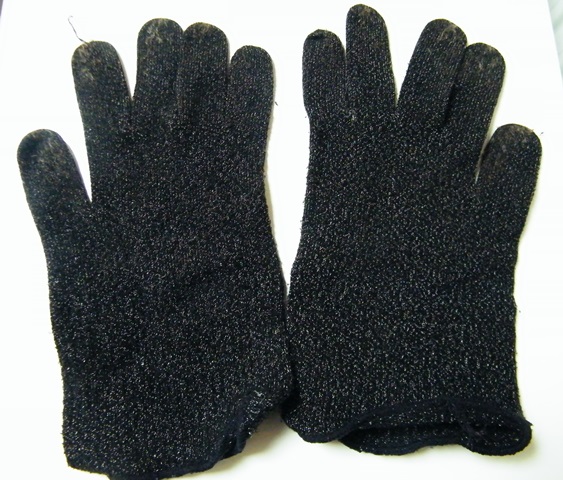
The second pair of gloves I could use with a touchscreen were these coffee-coloured ones, which had stitching on the thumbs and first fingers that did, indeed, allow me to work with touchscreens. They were a cotton and modal blend, and very soft. I wore them all summer to keep the sun off and enable me to touch and handle things. The seams were relatively unobtrusive.

Moisture wicking
Moisture wicking fabrics minus seams is something I now consider essential for a base layer, although there is very little choice when purchasing gloves without seams. Moisture wicking occurs when moisture is drawn away from the skin via capillary action. A useful feature of many synthetic fibres and fabrics designed for wicking is that they tend not to cling to the skin or feel soggy, as cotton does. Cotton can absorb a lot of water, but the water tends to remain held against the skin. This can be bad news for eczema sufferers like me whose eczema is triggered or worsened by soggy skin. I wish dermatologists weren’t quite so evangelic about cotton.
My current situation is that I have discovered Skinnies gloves, and favour them for being seamless and having good moisture wicking performance. If I wear them underneath my gardening gloves, for instance, my hands stay noticeably drier for longer, when compared with cotton. Skinnies are made of 86% viscose, 11% nylon and 3% elastane. They cover my wrists well. I can tuck my sleeves into them if I am gardening and want to keep irritants and the sun off my arms. They are sufficiently unobtrusive to wear for typing for a short periods, although not perfect by any stretch of the imagination. I can’t use a touchscreen when wearing them, but do now own a touchscreen stylus pen.
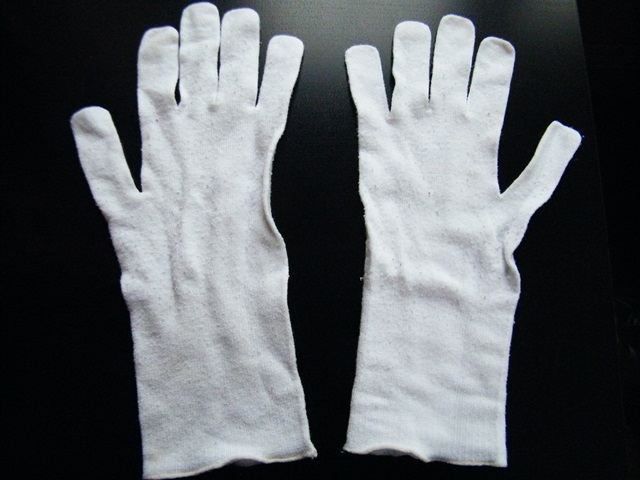
When out and about, my other mainstay is Foxgloves. These are great for rummaging around in a handbag, removing cash and cards from my purse, and doing most things normal people take for granted in their everyday lives. Made from Supplex® nylon and elastane, they last and last, and wash well. Designed by a gardener who had hand eczema they are sturdy and keep a lot of particles and the sun off the skin. At the same time, they are soft and breathable. The seams are bearable most of the time, and when my fingers are particularly sore, I wear my Foxgloves over the top of Skinnies. I have a black pair, which comes in useful for funerals and other formal occasions. I really couldn’t function without my Foxgloves.
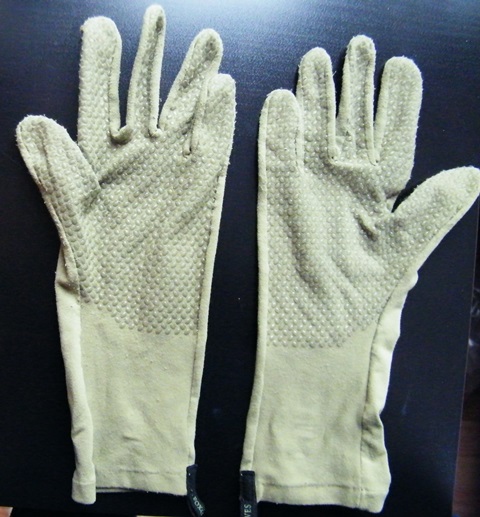
I have travelled a long and difficult journey in my efforts to live with often debilitating hand eczema. I would like dermatologists to wake up to the fact that there is a range of novel fabrics available as alternatives to cotton. Cotton is not the answer to everything.


